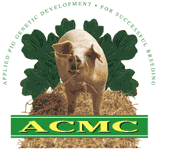 “Efficient feed conversion is the most important economic trait in pig production yet, as an industry, we are quite poor at measuring it,” Ed Sutcliffe, geneticist and technical director of pig-breeding company ACMC told a meeting of Northamptonshire Quality Pig Producers’ Association at Moulton College, near Northampton.
“Efficient feed conversion is the most important economic trait in pig production yet, as an industry, we are quite poor at measuring it,” Ed Sutcliffe, geneticist and technical director of pig-breeding company ACMC told a meeting of Northamptonshire Quality Pig Producers’ Association at Moulton College, near Northampton.
Producers record numbers born and have a reasonable idea of growth rate while backfat is measured for them when finished pigs are slaughtered. Yet none of these is as important as feed conversion rate (FCR).

Pointing out the relative importance of these factors, Mr Sutcliffe demonstrated that an improvement of one standard deviation in feed conversion (equivalent to about 0.4 FCR points) could be worth as much as £18. 52 per pig, assuming daily feed intake remained the same.
I n comparison, one standard deviation in grading was worth £1.51; in daily gain, £9.46, and numbers born alive, £5.91 per pig. While one standard deviation is a large change in a trait, it does allow the relative economic impact of each trait to be assessed.
n comparison, one standard deviation in grading was worth £1.51; in daily gain, £9.46, and numbers born alive, £5.91 per pig. While one standard deviation is a large change in a trait, it does allow the relative economic impact of each trait to be assessed.
He accepted that getting accurate feed conversion figures could be difficult to do, particularly for producers with automatically-fed pigs in continuous-flow, intensive buildings.
“Everyone makes a conscious decision when to market pigs – generally as heavy as possible – but do they know how the FCR of their pigs differ through the growth curve?” he queried. “A little effort is required, but measuring some pigs later in the growth curve would allow this to be considered and could surprise those producers not using feed efficient genetics about the lack of return at heavier weights,” he said.


